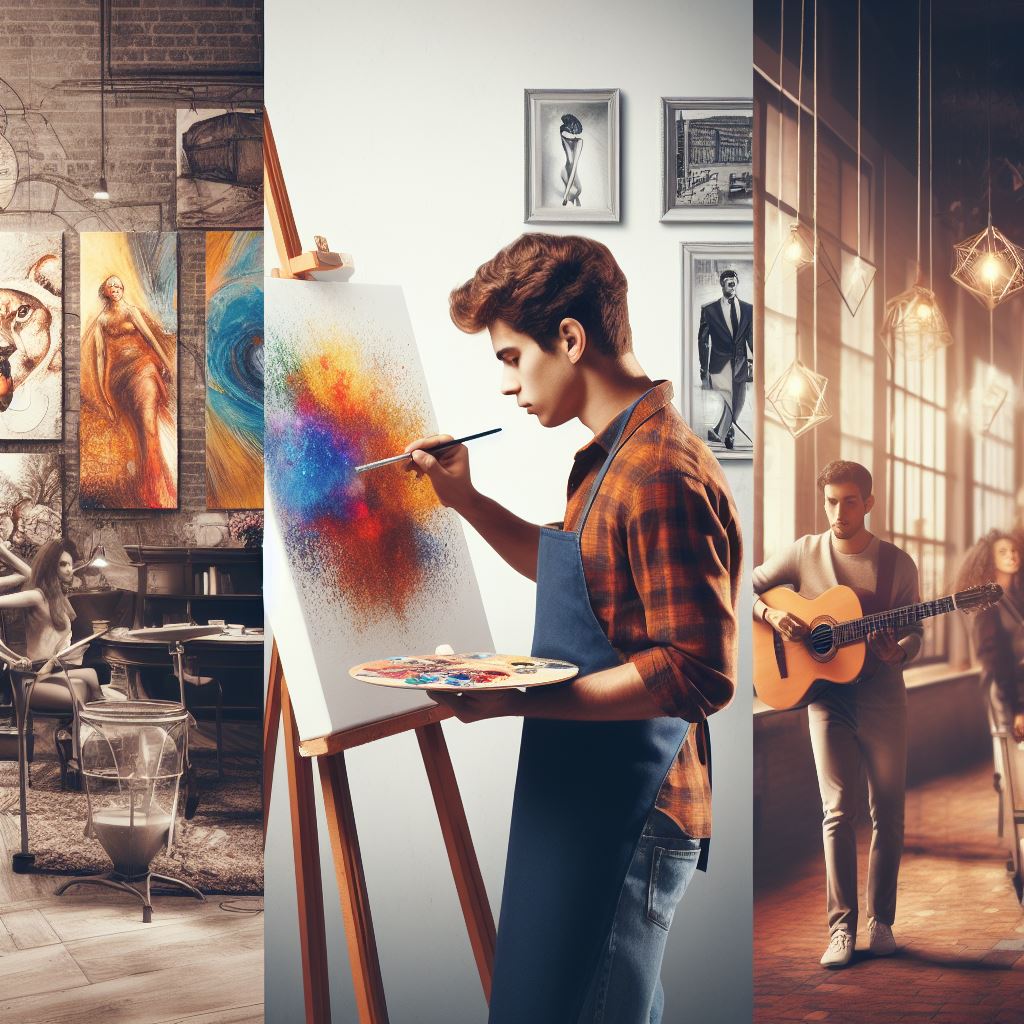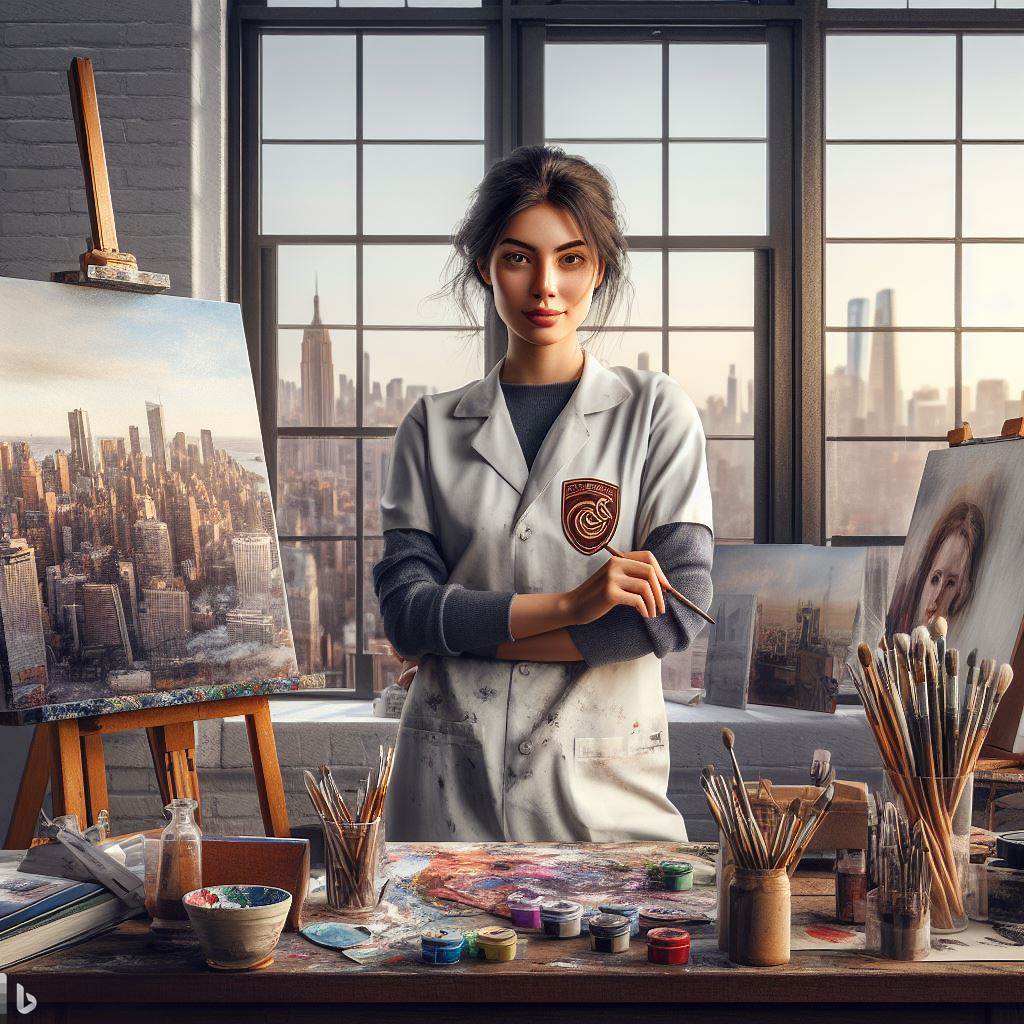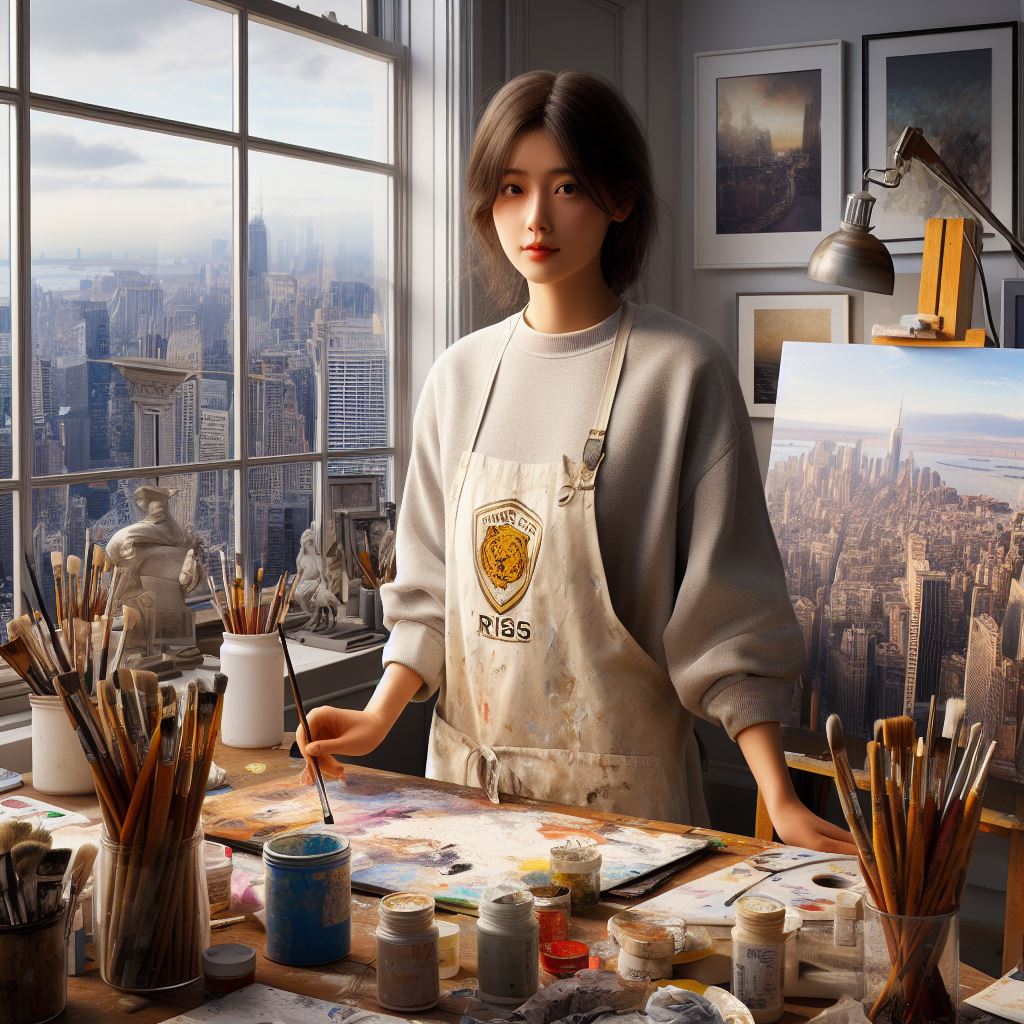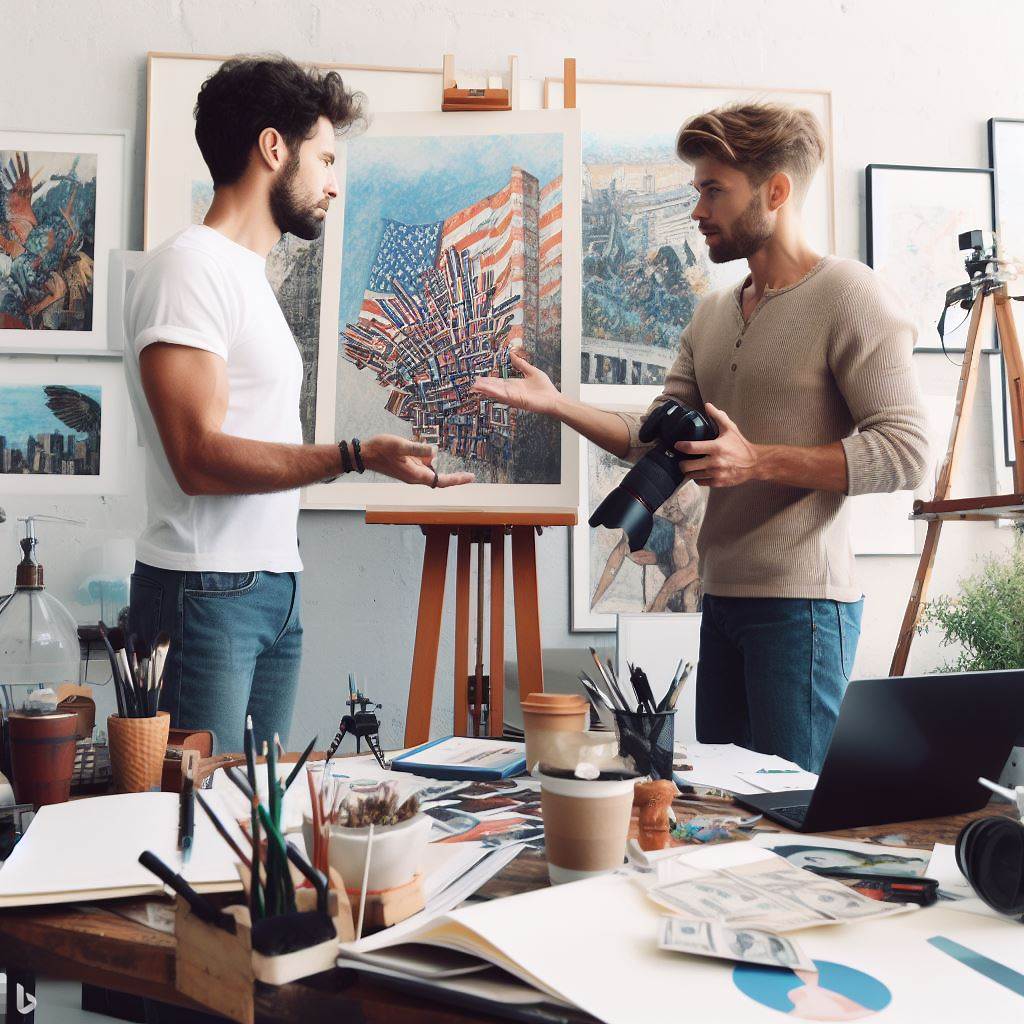Introduction
Brief explanation of the topic
Artistic careers in the USA have undergone dynamic shifts over decades, reflecting societal changes, technological advancements, and cultural trends.
Importance of understanding the evolution of the artist career in the USA
Comprehending the trajectory of artists’ careers is paramount as it unveils insights into the nation’s cultural pulse, influences on creative expressions, and the impact of external factors.
This journey through time not only chronicles the metamorphosis of individual artists but also serves as a mirror reflecting the broader evolution of American society.
Exploring this timeline is essential for artists, enthusiasts, and cultural historians, providing a contextual foundation to navigate the present and anticipate the future in the ever-evolving landscape of artistic pursuits in the United States.
Early Years: Pre-19th Century
Overview of art as a profession during this period
- Art was not widely considered a profession, but rather a skilled trade.
- Artists were often regarded as artisans, craftsmen, or tradesmen.
- They were not esteemed as independent creators or intellectuals.
- Painters, sculptors, and other artists were mostly seen as skilled laborers.
Influence of European traditions and patronage system
- European traditions heavily influenced the art scene in the early years.
- Artists were often trained in European techniques, styles, and subjects.
- Patronage system played a crucial role in the art world.
- Wealthy individuals, nobility, and the church were the primary patrons of art.
Limited opportunities for American artists
- American artists faced limited opportunities for recognition and financial stability.
- There were a few notable exceptions, but overall, it was a challenging career choice.
- The American art market was still in its early stages and lacked significant demand.
- Major cities like New York and Boston provided some opportunities, but they were scarce.
Examples of notable artists and their challenges
- Benjamin West, one of the earliest American artists, faced skepticism and prejudice.
- West had to move to London in pursuit of better opportunities and recognition.
- John Singleton Copley faced similar challenges and also relocated to London.
- They both found success and acclaim abroad but struggled to gain recognition in America.
Generally, the early years of the artist career in the USA were characterized by limited opportunities, European influence, and challenges for American artists.
Art was not seen as a profession but rather a skilled trade, and artists often found themselves reliant on the patronage system.
While some artists managed to find success abroad, they struggled to gain recognition in their homeland. The art market in America was still developing, and the demand for art was not significant.
Despite these challenges, these early years laid the groundwork for the evolution of the artist career in the USA.
Read: Breaking into the US Market: Tips for Aspiring Photographers
The 19th Century: Rise of the American Art Market
Industrial Revolution and its impact on the art industry
The Industrial Revolution in the 19th century brought significant changes to the art industry in the United States.
This period marked a transition from handmade goods to mass production, which influenced the way art was created, consumed, and sold.
The availability of cheap materials and the rise of mechanization led to the production of reproductions and prints, making art more affordable and accessible to a wider audience.
This shift in production methods also impacted artistic styles and subject matter, as artists began to depict industrial landscapes and the changing urban environment.
Emergence of art schools and academies
As the demand for artistic skills increased, art schools and academies emerged across the United States.
These institutions provided formal training and education for aspiring artists, establishing a foundation for the development of American art.
The Pennsylvania Academy of the Fine Arts, founded in 1805, was among the first art schools in the country.
It played a crucial role in nurturing American talent and promoting a distinctive national identity in art.
Growth of art galleries and exhibitions
The 19th century witnessed the growth of art galleries and exhibitions as commercial entities. With the rise of the middle class and increased disposable income, art consumption became a popular pastime.
Galleries and exhibitions provided a platform for artists to showcase and sell their work, stimulating the art market.
The National Academy of Design in New York City, founded in 1825, organized annual exhibitions that showcased the best of American art, contributing to the recognition and success of many artists.
Transform Your Career Today
Unlock a personalized career strategy that drives real results. Get tailored advice and a roadmap designed just for you.
Start NowIncreased opportunities for American artists and their recognition
The 19th century was a pivotal period for American artists as they gained increased opportunities for exposure and recognition.
Previously, American artists had looked to Europe, particularly Paris, for validation and patronage.
However, with the growth of the American art market and the establishment of institutions like the National Academy of Design, American artists found recognition and support within their own country.
This enabled them to develop their own artistic identities and contribute to the flourishing art scene in the United States.
Expansion of art collectors and patrons
The 19th century also witnessed a significant expansion of art collectors and patrons in the United States.
As the middle class grew and more people became interested in art, collectors emerged, creating a demand for American artwork.
Prominent art collectors like William T. Walters and Isabella Stewart Gardner played crucial roles in supporting artists and building significant private art collections.
Their patronage contributed to the development of the art market and the establishment of prominent art institutions in the 19th century.
Basically, the 19th century marked a dynamic period in the evolution of the artist career in the USA.
The Industrial Revolution, the emergence of art schools and academies, the growth of art galleries and exhibitions, increased opportunities for American artists.
The expansion of art collectors and patrons all played significant roles in shaping the American art market and establishing a unique artistic identity.
Read: The Role of Photography Associations in the USA
Early 20th Century: Exploring Modernism
Shift towards modernism and new artistic movements
During the early 20th century, artists in the USA began to embrace modernism and experiment with new artistic movements.
The traditional approach to art was challenged, and artists aimed to break away from established norms.
Influenced by European art movements such as Cubism and Fauvism, American artists like Georgia O’Keeffe and Marsden Hartley explored innovative ways of expressing themselves.
They experimented with abstraction, bold colors, and geometric shapes to capture the essence of their subjects.
Influence of World War I and social change on the artist career
The outbreak of World War I had a profound impact on the artist career in the USA. The war led to a significant shift in societal values and attitudes, which in turn influenced artists’ work.
The horrors of war and the search for meaning in a rapidly changing world pushed artists to explore new themes and techniques.
Many artists turned their focus towards depicting the human experience during the war, reflecting the anxieties and disillusionment of the time.
Formation of artist groups and societies
In response to the societal changes brought about by World War I, artists began to form groups and societies to support and promote their work.
Transform Your Career Today
Unlock a personalized career strategy that drives real results. Get tailored advice and a roadmap designed just for you.
Start NowThese communities provided a platform for artists to exchange ideas, exhibit their art, and discuss new artistic theories.
One notable example is the Ashcan School, a group of artists including George Bellows and John Sloan.
They focused on depicting the grittier aspects of urban life, often exploring themes of poverty and social inequality.
Noteworthy American artists and their contributions
Several American artists emerged during the early 20th century and made significant contributions to the artist career. Their unique styles and perspectives helped shape the evolution of American art.
Georgia O’Keeffe, known for her large-scale flower paintings and desert landscapes, challenged traditional notions of femininity and explored the power of abstraction.
Marsden Hartley’s bold and expressive paintings captured the energy and emotion of the American landscape, celebrating the beauty of nature and identity.
The works of Edward Hopper conveyed a sense of isolation and introspection, reflecting the increasing urbanization and individualism of the time.
Essentially, the early 20th century marked a period of transformation and exploration in the artist career in the USA.
Artists shifted towards modernism, influenced by new artistic movements and the social changes brought about by World War I.
The formation of artist groups and societies provided support and collaboration opportunities.
Noteworthy American artists like Georgia O’Keeffe, Marsden Hartley, and Edward Hopper made significant contributions, pushing the boundaries of artistic expression.
This era set the stage for further evolution and growth in the artist career in the USA.
Read: Portrait Photography: Navigating the US Market & Trends
Mid-20th Century: Post-WWII Art Boom
Impact of World War II on the art world
World War II brought significant changes to the art world in the United States. Artists were deeply affected by the war, witnessing destruction and devastation firsthand.
Many artists found themselves serving in the military, where they experienced the horrors of war. These experiences led to a shift in artistic expression, as artists sought to grapple with the trauma of war.
Rise of abstract expressionism and other modern art forms
One of the most significant developments during this period was the rise of abstract expressionism. This movement emphasized the artist’s inner emotions and explored new forms of artistic representation.
Pioneers such as Jackson Pollock, Willem de Kooning, and Mark Rothko gained prominence during this time.
Abstract expressionism challenged traditional techniques and ushered in a new era of artistic experimentation.
Artists gaining international recognition
The post-WWII period also saw American artists gaining international recognition and acclaim. Artists like Jackson Pollock and Mark Rothko became famous figures on the global art scene.
These artists showcased American talent and creativity, cementing the country’s reputation as a cultural hub. Their works were exhibited in prestigious galleries and museums around the world.
Transform Your Career Today
Unlock a personalized career strategy that drives real results. Get tailored advice and a roadmap designed just for you.
Start NowGovernment support and establishment of art institutions
The US government recognized the importance of art and established various institutions to support artists.
The National Endowment for the Arts (NEA) was created in 1965 to provide grants and funding to artists.
Art centers and galleries began to receive government support, encouraging artistic growth and development.
This investment helped nurture a thriving art scene and fostered the career paths of many artists.
Popularity of art collecting and patronage in the USA
The mid-20th century witnessed a surge in the popularity of art collecting and patronage in the USA.
Wealthy individuals and collectors began investing in artworks, driving up demand and prices.
This increased patronage created opportunities for artists to showcase their works and earn a living.
The art market became more commercialized, leading to the establishment of galleries and art dealerships.
In general, the mid-20th century brought significant transformations to the artist career in the USA.
The impact of World War II, the rise of abstract expressionism, and international recognition shaped the art world.
Government support and the establishment of art institutions provided resources and opportunities for artists.
Additionally, the popularity of art collecting and patronage fueled the commercialization of the art market.
This period marked a turning point in the evolution of the artist career, setting the stage for further developments.
Read: Photography Trends in the USA: What‘s Hot in 2024?

Find Out More: How to Use 3D Printing in Furniture Design
Late 20th to Early 21st Century: Art in a Digital Age
Advancements in technology and their influence on the artist career
- The late 20th century saw rapid advancements in technology that transformed the art world.
- Artists began incorporating new tools and mediums into their creative processes.
- Digital art software such as Photoshop revolutionized the way artists manipulate and create images.
- Artists embraced technology as a means to expand their artistic expression and reach wider audiences.
- Advancements in printing technology enabled artists to easily reproduce their work in high quality.
Rise of digital art and multimedia platforms
- The rise of digital art in the late 20th century opened up new possibilities for artists.
- Artists started experimenting with computer-generated imagery and interactive installations.
- Video art became increasingly popular, blurring the boundaries between art and technology.
- Multimedia platforms like YouTube and Vimeo provided artists with a global stage to showcase their work.
- Virtual reality and augmented reality technologies introduced new immersive art experiences.
Changing dynamics of art galleries and exhibitions
- The digital age brought significant changes to the dynamics of art galleries and exhibitions.
- Galleries began incorporating digital installations and interactive exhibits into their shows.
- Artists started exploring non-traditional exhibition spaces such as warehouses and abandoned buildings.
- Online galleries emerged, allowing artists to showcase and sell their work to a global audience.
- Curators started embracing digital art, organizing exhibitions dedicated to digital and new media art.
Accessibility of art through the internet and social media
- The internet and social media revolutionized the accessibility of art.
- Artists could now share their work instantly with a global audience through their websites and social media platforms.
- Online art communities and forums provided artists with valuable networking opportunities and feedback.
- Artists could engage directly with their fans and build a loyal following through social media interactions.
- The internet also democratized the art market, allowing artists to sell their work directly to collectors.
In review, the late 20th to early 21st century marked a significant shift in the artist career due to the digital age.
Advancements in technology provided artists with new tools and mediums to explore, leading to the rise of digital art and multimedia platforms.
Art galleries and exhibitions adapted to the changing dynamics by incorporating digital installations and embracing non-traditional exhibition spaces.
The internet and social media made art more accessible than ever, allowing artists to connect with a global audience and sell their work directly.
The evolution of the artist career in the USA continues to be shaped by the rapid advancements in technology and the changing landscape of the digital age.
Transform Your Career Today
Unlock a personalized career strategy that drives real results. Get tailored advice and a roadmap designed just for you.
Start NowPresent-Day: Challenges and Opportunities
Current state of the artist career in the USA
- The artist career in the USA is vibrant and diverse, with a growing number of artists pursuing their passion.
- Artists face challenges such as financial instability, lack of access to resources, and limited recognition.
- However, there are also opportunities for artists to showcase their work through various platforms and connect with a global audience.
Impact of globalization on the art industry
- Globalization has revolutionized the art industry, providing artists with the ability to reach a wider market.
- The internet and social media have played a significant role in connecting artists with collectors and art enthusiasts worldwide.
- Artists now have access to international art fairs, exhibitions, and collaborations, expanding their potential reach and impact.
Demands of the digital age and evolving audience expectations
- The digital age has led to a shift in audience expectations, with a growing demand for interactive and immersive art experiences.
- Artists need to adapt to new technologies and explore digital mediums to meet the evolving needs of their audience.
- The rise of social media platforms and virtual reality has created exciting opportunities for artists to engage with their audience in innovative ways.
Changing approaches to art education and training
- Art education and training programs are evolving to prepare artists for the demands of the modern art industry.
- There is a greater emphasis on interdisciplinary approaches, encouraging artists to explore diverse mediums and techniques.
- Art schools and universities are incorporating business and marketing courses to equip artists with entrepreneurial skills.
Notable trends and emerging artist career opportunities
- Collaborative art projects, public installations, and community engagement have become prominent trends in the artist career.
- Artists are finding opportunities in the fields of art therapy, cultural diplomacy, and sustainable art practices.
- Artist residencies and fellowships are providing artists with valuable support, resources, and networking opportunities.
- Online art marketplaces and crowdfunding platforms have democratized the art industry, allowing artists to fundraise and sell their work directly to buyers.
To sum it up, the artist career in the USA is both challenging and full of opportunities.
Artists need to navigate the demands of the digital age and evolving audience expectations while also taking advantage of global connections and emerging trends.
With changing approaches to art education and training, artists are better equipped to succeed in the modern art industry.
The impact of globalization has opened up new avenues for artists to showcase their work and connect with a broader audience.
As the artist career continues to evolve, artists must stay adaptable and seek out innovative ways to thrive and make a meaningful impact in the ever-changing art world.
Conclusion
Recap of the evolution of the artist career in the USA
The artist career in the USA has undergone significant changes over the years. Initially, artists struggled for recognition and financial stability, but with the rise of galleries and patronage, opportunities improved.
The growth of the art market and the professionalization of the industry further transformed the career path for artists.
The digital age and globalization have brought new challenges and opportunities, with artists having to navigate online platforms and social media to gain exposure.
Reflections on the importance of understanding this evolution
Understanding the evolution of the artist career in the USA is crucial for artists to adapt and thrive in a rapidly changing industry.
By recognizing the historical context and trends, artists can make informed decisions about their artistic practice, marketing strategies, and career goals.
Encouragement for artists to adapt and seize new opportunities
In the face of constant change, artists must be adaptable and open to new opportunities.
Embracing technology, collaborating with other artists, and seeking alternative avenues for exposure can help artists stay relevant and successful.
By being proactive and taking risks, artists can capitalize on the changing landscape and forge their own unique paths.
Final thoughts
While the evolution of the artist career in the USA has been marked by challenges and uncertainties, it has also presented artists with new possibilities.
By understanding the past, artists can shape their futures and contribute to the ever-evolving world of art.
It is an exciting time for artists who are willing to adapt, seize new opportunities, and push the boundaries of their creative endeavors.
The future holds great potential for those who embrace change and continue to pursue their artistic passions.




